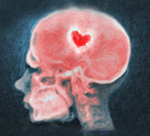 In an article in Psychology Today (12.4.2009) entitled What Makes Tigers Jump?, Professor of Psychology Harvey Milkman* looks at the much-discussed phenomenon of “love addiction,” clinically labelled “hysteroid dysphoria” by the New York State Psychiatric Insitute in 1979. Clinicians at the Institute labelled as a disorder a chronic and intense form of lovesickness they were observing with surprising frequency in the course of their psychiatric practice; the disorder was characterized by depression, depletion of energy, and increased appetite in response to feelings of rejection.
In an article in Psychology Today (12.4.2009) entitled What Makes Tigers Jump?, Professor of Psychology Harvey Milkman* looks at the much-discussed phenomenon of “love addiction,” clinically labelled “hysteroid dysphoria” by the New York State Psychiatric Insitute in 1979. Clinicians at the Institute labelled as a disorder a chronic and intense form of lovesickness they were observing with surprising frequency in the course of their psychiatric practice; the disorder was characterized by depression, depletion of energy, and increased appetite in response to feelings of rejection.
In the following selection from his longer article, Milkman explores the experience of love through the prism of neurochemical analysis.
* * *
In proper proportion, the majestic clockwork of love — a synchronized blend of arousal, satiation, and fantasy — gives rise to life’s most fulfilling experience. By nature, we become impassioned by elements that create or sustain life. But all too often the delicate process goes amiss: angels transform into devils, joy becomes jealousy, and heaven changes to hell.
While the language of love is undoubtedly poetry, the language of the brain is chemistry. We respond chemically to other human beings. In fact, romantic attachment has been attributed in part to oxytocin, a hormone first released when the baby is nursing and in subsequent love connections throughout life.
Love itself has become a legitimate target for neurochemical analysis. Anthropologists at Rutgers University recruited subjects who claimed to be “madly in love” for an average of 7 months (Fisher, Aron, & Brown, 2005). Each was shown a neutral photo and one of their beloved. MRI data showed that love lights up the caudate nucleus which is home to a rich network of dopamine receptors.
According to Liebowitz, author of The Chemistry of Love (1983), the initial period of psychosexual attraction produces increased concentrations of the neurotransmitter-like substance phenylethylamine (PEA). The PEA molecule, which is considered an excitatory amine, bears striking structural similarity to the pharmaceutically manufactured stimulant amphetamine. And the brain responds to PEA much as it does to amphetamine or cocaine; infatuated lovers seem to experience boundless energy, elation, focused attention and a remarkable sense of well-being.
Surging levels of dopamine and norepinephrine, that electrify the reward centers of the brain, are referred to by the French as la coup de foudre (“lightning bolt”).
After a short time, however, the speedy feeling appears to reach a maximum level, and lovers begin to recognize that their relationship is on a plateau. The romance remains exciting, yet the remarkable sensations of invigoration and euphoria appear to be dwindling. In chemical terms, the pleasure of falling in love is derived not from increased production of PEA, but rather from steady increases in the rate of PEA production. When PEA acceleration reaches zero, that is, when increments in the rate of chemical reward have stopped, the honeymoon stage is over. Although there is obviously great variation between couples, some speculate that the infatuation phase is timed to expire in about 18 months.
At this juncture, one of two possible biochemical processes becomes operative: amphetamine-like withdrawal, or a shift to an endorphin-mediated relationship. Long-term lovers are able to make the transition from zooming around in the fast lane to enjoying cuddles and quiet evenings at home, [editor’s addition: … and to learning how to be loving, compassionate, generous partners!]
But consider the chemistry of contentment. The prolonged love-swoon is, after all, an opiate-mediated experience. If one member of the relationship is a “dyed in the wool” arousal type, he or she may seek excitement from people and places outside the relationship. The pair-bond may dissolve as one or the other partner subjectively experiences boredom, stagnation and depression.
* * *
* Dr. Harvey Milkman is professor of psychology at Metropolitan State College of Denver. He specializes in cognitive-behavioral approaches to mood alteration.